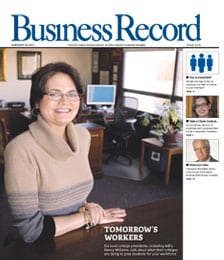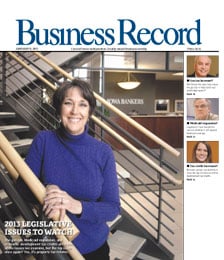From farming to TV, Meredith has grown with America

On June 20, Meredith Corp. Chairman and Chief Executive William Kerr rang the closing bell of the New York Stock Exchange, an honor reserved for few corporate executives. With three Meredith flags draped across the exchange’s rostrum, the event celebrated the company’s 100th anniversary.
It also served as a milestone for a company that began life as a publisher of a politically charged newspaper and has since evolved into the publisher of some of the world’s most widely read magazines, including Better Homes and Gardens and Ladies’ Home Journal.
Today, Meredith owns 11 television stations around the United States, and its formidable book publishing division provides more than 300 titles annually. It has sold 34 million copies of its famed Better Homes and Gardens Cook Book. The company employs 2,800 people throughout the country, including 900 in Des Moines. It has major offices in New York City, Chicago, Detroit, San Francisco and Los Angeles.
Throughout the company’s century of life, Meredith has continued to benefit from its focus on the family. As the U.S. economy has grown, and as home ownership has risen – particularly in the years immediately following World War II – Americans have increasingly turned to Meredith publications for guidance on everything from parenting and cooking to travel and home improvement.
“Better Homes and Gardens was the flag carrier for the entire post-World War II environment, and it has mushroomed into one of the most successful publishing phenomena in the history of the business,” said Bob Burnett, a former chairman and chief executive of Meredith, who spent 45 years working at the company.
Meredith founder Edwin Thomas Meredith, who grew up on a farm near Marne in Cass County, first came to Des Moines in 1892 to study business at Highland Park College. His grandfather, Thomas, was one of western Iowa’s biggest landowners and had become owner of the Farmers’ Tribune, a Des Moines-based newspaper, that same year, according to a book of the company’s history that is scheduled to be published soon.
His grandfather’s favorite, Edwin Thomas, who generally went by his initials, E.T., quit school a year after he enrolled when Thomas offered him a job at the newspaper. In 1894, at the age of 18, E.T. was named general manager. On E.T.’s wedding day a year and a half later, Thomas gave him half of the newspaper as a wedding gift.
E.T. bought the remaining stake in 1896 and transformed it from a political organ to one dominated by market reports and agricultural news. In a signal of where Meredith would eventually take his company, the redesigned newspaper also included columns about family issues, according to the company history.
By 1900, the newspaper’s weekly circulation stood at 300,000, and farm-related advertisements outnumbered those for patent medicines. That year, it became profitable, though debts continued to trouble the publication.
During this time the American economy was undergoing a tremendous shift. Tractors were replacing animals as the tool of choice for cultivating land, so farmers were able to plow far more acreage than ever before. Between 1890 and the 1920s, annual sales of farm-related products jumped from about $700 million to nearly $2 billion. Farms in the Midwest were among the most productive and prosperous.
The success of the Tribune was limited by its reputation of being political. In 1900, Meredith began plans for a new publication that would focus more on farming and the Midwest. It was a 16-page magazine called Successful Farming, and reflecting Meredith’s views, contained articles supporting Prohibition and accepted no tobacco advertising, according to the book on company history.
Meredith sold the Tribune in 1904 and focused his attention solely on Successful Farming. Readership of the magazine, which was full of how-to articles and promotions, had a circulation of 80,000. By 1906, readership would rise to 300,000.
That year, Meredith moved the company’s headquarters to a building that faced the Hotel Fort Des Moines. Five years later, in 1911, Successful Farming’s circulation hit 500,000, and Meredith bought 2.8 acres of vacant land between Locust Street and the Raccoon River, according to the book on company history.
It was there that Meredith would build the four-story red brick building that still serves as his company’s home. Over the next 90 years, the headquarters building would undergo seven additions and alterations, including the most recent, a 1998 renovation that cost $40 million.
Meredith would again become involved in politics in 1914, when he ran unsuccessfully for U.S. Senate. That race, along with another unsuccessful bid for Iowa governor in 1916, brought him national name recognition that would later win him a spot as director of the Federal Reserve Bank in Chicago, according to the book on company history.
In 1920, Meredith was named by President Woodrow Wilson as secretary of agriculture, though the appointment lasted just 11 months because of Warren Harding’s win that year.
Meredith returned to Des Moines from Washington, D.C., with an idea for a new magazine that would secure his company’s future.
Fruit, Garden and Home, which would later become Better Homes and Gardens, began in 1922. Patterned on the same model as Successful Farming, the new magazine was designed to help homeowners better tend their gardens and decorate their homes.
The country was again at a crossroads during the 1920s, when the number of Americans living in urban settings for the first time exceeded those living in rural areas. Meredith’s Fruit, Garden and Home, which cost 10 cents and was 52 pages, was aimed squarely at America’s changing demographics.
The magazine lost an estimated $200,000 in its first year, and another $130,000 the following year, according to the company’s history book. Meredith changed his company’s name in 1925 from Successful Farming Publishing Co. to Meredith Publishing Co.
By 1927, Better Homes and Gardens, as it was now called, had a circulation of 1 million – the first magazine without fashion or fiction to reach that mark. That year was also the first in which it turned a profit. Meredith died on June 17, 1928, at the age of 51. Overwork and a weak heart were generally believed to have been the cause, the book reports.
Josephus Daniels, who had been secretary of the navy under President Wilson, gave an address at a memorial service for Meredith at Des Moines’ Shrine Temple auditorium. Two thousand people were on hand to hear the speech.
Meredith’s son, E.T. “Ed” Meredith Jr., was still in college when his father died and judged too young to take over the company. Fred Bohen, Meredith’s son-in-law, took charge.
In 1930, the company published “My Better Homes and Gardens Cook Book,” which sold 40,000 copies in three months. Sales would hit 100,000 by 1932. The book was largely introduced as a promotion for the magazine. Potential readers would get a copy for free if they paid $1 upfront for a two-year subscription, according to the book on company history.
In the midst of the Great Depression, Bohen changed the subscription format for Better Homes and Gardens from one year to six months. The reason was simple. He wanted to appear as though he was cutting prices,without lowering them significantly. At that time, an annual subscription for the magazine cost 60 cents. Bohen lowered the price to 25 cents for six months. The tactic worked and circulation jumped by 350,000 to more than 1.4 million.
Bohen also cut salaries and eliminated the company’s dividend for several years to further save money. The dust bowl days of the early 1930s forced thousands of farmers off their land, hurting Successful Farming’s base.
Meredith opened its New York office in 1934, just three years after the Empire State Building was completed. The next year, it opened offices in Dallas and Los Angeles.
The combination of the cookbook and Better Homes and Gardens proved lucrative for several reasons. Sales of the cookbook helped buoy the company during the Depression. Second, when paired with Better Homes and Gardens, the cookbook opened Meredith to a new category of advertisers, including Kellogg Co., Del Monte Foods Co., H.J. Heinz Co. and Pillsbury, which is now a unit of General Mills Inc.
Ed Meredith, who at that point was the company’s treasurer, was elected vice president.
In 1937, Better Homes and Gardens, now offering recipes each month, prepunched its recipe pages so they could be pulled easily from the magazine and added to the cookbook.
Another innovation, offering building plans to readers for purchase, was added in 1932. By 1938, 115,000 subscribers had asked for materials lists for the homes and 13,000 home plans had been sold, according to the book on company history.
The success led to the creation of Meredith’s first so-called special interest publication: Better Homes and Gardens Home Building Ideas. The company now publishes more than 100 special interest issues on topics that range from cooking and decorating to building, remodeling, crafting and gardening.
Circulation during that portion of the Depression increased to 1.75 million. During World War II, with rations restricting the availability of most commodities, including paper, Bohen chose to cut the size of Better Homes and Gardens in half rather than lose subscribers, according to the book on company history.
In 1945, anticipating a renewed focus on the home, Meredith ordered more presses for Successful Farming and Better Homes and Gardens. The GI Bill of Rights made home ownership possible for millions of returning American servicemen. Suburbs sprang up around most cities. Better Homes and Gardens, full of advertisements for furniture, appliances and other household items, flourished. By 1946, circulation hit 2.9 million.
Meredith continued to expand as well. Employment reached 1,214 in 1947, according to the book on company history.
The company’s book division, responsible for the cookbook, branched out to create new how-to books on parenting and stories for young children.
In 1948, again trying to stay ahead of American’s changing interests, Meredith paid $500,000 to create its first television station in Syracuse, NY. Today the company owns stations in Atlanta; Phoenix; Hartford, Conn.; Kansas City, Mo.; Nashville, Tenn.; Greenville, S.C.; Las Vegas, Nev.; Flint, Mich., and in Bend, Ore.
Ed Meredith, who grew to understand television’s potential while serving in the U.S. Navy during World War II, is credited with pushing Meredith into the broadcasting business, according to the book on company history.
Most recently, under Broadcasting Group President Kevin O’Brien, Meredith earlier this year formed a duopoly in Portland, Ore., when it agreed to exchange stations in Orlando and Ocala, Fla., for Portland’s KPTV.
The move is expected to help Meredith, which now operates Fox and UPN affiliates in Portland, cut costs and boost its ability to reach portions of the Portland population that are more attractive to advertisers. The company’s broadcasting division accounted for about a quarter of Meredith’s total sales in fiscal 2001.
By the 1950s, Meredith was generating plenty of cash, and top executives were looking for new areas in which to expand. Five of the company’s books made 1954’s top-10 best-selling list, according to the book on company history.
Bohen decided education textbooks would be Meredith’s next territory to conquer. The company bought Chicago-based globe maker Replogle Globe Inc. In 1960, Meredith acquired Appleton-Century-Crofts, a publisher of trade books and textbooks. Three more textbook-related purchases following within the next few months.
The strategy was clear, though the thinking behind it wasn’t. Meredith’s executives didn’t understand the market for education the same way they did homemaking. Profits, which passed $4 million in 1954, slid below $2 million by 1962.
Another weight on Meredith’s profits was the counterculture movement of the 1960s. Everything that made Meredith successful in the past, the emphasis on home and the family, become a liability.
In fact, at one point, an executive suggested that Better Homes and Gardens drop the “Gardens” in its name. The idea was rejected. Still, Better Homes and Gardens, which was 414-page magazine at one point in 1953, shrank to fewer than 100 pages in the 1960s.
“It was almost impossible to get advertisers to even listen to us,” Burnett said. “They thought Better Homes and Gardens was a dinosaur, a thing of the past.”
In 1963, Burnett, who was then advertising director, worked to refocus the magazine toward helping families better manage their lives. A constant editorial theme of home and family gradually won over reluctant advertisers.
Better Homes and Gardens’ circulation hit 7 million in 1967, the same year that Meredith again changed its name, this time to its current Meredith Corp.
Meredith stock, which had been publicly traded since the 1940s, began trading on the New York Stock Exchange in 1965.
In 1966, Ed Meredith died at the age of 60. He was the first pilot to land a private plane at Des Moines airport in 1931. In 1936, he held the world record for catching a 613-pound tuna off the coast of Nova Scotia. He sat on Drake University’s board of trustees for 17 years.
Following Ed Meredith’s death, his son, Ted, joined the company’s board. Bohen, who had led the company for 40 years through much of its growth, was now seen as standing in the way of Meredith’s continued success. Succession became an issue.
It was Ted Meredith who orchestrated Bohen’s removal from daily management of the company. Darwin Tucker was named chief executive in 1968, the first person from outside the Meredith family to run the company.
Tucker resigned three years later, a move that led to Ted being named president and chief executive in 1971. He would hold the title of president until 1973 and chief executive until 1988.
In the early 1970s, Burnett suggested the company move its headquarters to New York City. Ted Meredith opposed it. Still, recognizing the importance of Manhattan to the publishing industry, Ted Meredith bought the first of the company’s jets in order to whisk executives to New York and the company’s other offices quickly.
“They provided us with the mobility that made it possible for us to have a presence in New York and all of our other locations,” Burnett said. “It would have been crazy for us to depend on commercial aviation.”
Meredith’s biggest liability in the early 1970s was its cash flow, largely because of short-term debt that the company relied on to maintain day-to-day operations. Led by Burnett, who was now president and chief operating officer, the company explored a bond sale, Burnett said.
Meredith also looked for ways to make better use of its expensive, and relatively new, printing plant. The company contracted with Penthouse magazine founder Bob Guccione to print the men’s magazine at its plant. The decision caused a stir among some workers and made national headlines in the media.
Regarding the sale of bonds, company executives and board members decided during a weekend retreat in the early 1970s to sell the textbook subsidiaries and other operations that weren’t central to its core businesses. Rather than sell bonds, Meredith executives arranged lines of revolving credit with local banks. The debt was paid off in three years, according to the book on company history.
Profits began to soar once more. Meredith’s special interest publications became a breeding ground for new magazines. Country Home and Traditional Home, for example, began as special interest publications.
In 1982, Burnett passed on the chance to buy Southern Living, having been told by the company’s finance experts that the purchase would be too costly.
“That was one of my biggest mistakes,” Burnett said.
In 1985, not wanting to pass up another opportunity of that size, Meredith bought Ladies’ Home Journal, one of Better Homes and Gardens’ biggest rivals.
In 1988, Jack Rehm was named president and chief operating officer. Burnett became chairman and chief executive. Ted Meredith was named chairman of the executive committee.
Meredith sold its interest in the printing business to R.R. Donnelley & Sons Co. in 1990. Burnett retired in 1992 and Rehm was named chairman.
The recession of the early 1990s forced Meredith to cut its costs and its workforce. By the end of the economic downturn, more than 220 people had lost their jobs, according to the book on company history.
William Kerr, who joined the company in 1991 from the New York Times Co., was named president and chief operating officer in 1994.
Kerr has worked to focus Meredith’s employees on service to customers and on the company’s shareholders. The company’s stock prices were posted on signs in the cafeteria and in the lobby in 1995, according to the book on company history. He also struck out to find new ways for the company to grow.
Meredith signed an agreement with Wal-Mart Stores Inc. in the mid-1990s that licensed Wal-Mart’s lawn and garden departments as Better Homes and Gardens Garden Centers. Each of the centers had a rack filled with Meredith publications.
That move was the first of several partnerships Meredith would enter in to. Most recently, the company signed an agreement with Wegmans Food Markets Inc., a regional grocery chain based in Rochester, N.Y.
In the wake of last year’s terrorist attacks and the U.S. recession, Meredith today is recovering from one of the most difficult advertising environments since World War II.
The company has a host of new products it hopes will boost sales and profits, including a new magazine it’s currently testing called Living Room. It also has an aggressive new leader for its broadcast division, O’Brien, who is revamping the management and on-air talent at each of its television stations.
Within its book division, the recently released 12th edition of the “Better Homes and Gardens Cook Book” is selling strongly and was recently ranked among the top 50 of all book sales in the United States.
Next week: The Business Record will explore Meredith’s economic and philanthropic ties to Des Moines. Many of the city’s cultural institutions, including the Des Moines Art Center and the Science Center of Iowa, have been made possible through the leadership and contributions from both members of the Meredith family and from employees of the company.







